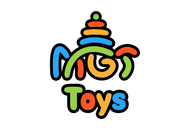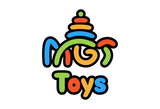Toys are not selected for children merely to keep them busy—they are designed to create them and work towards their growth and development in an entertaining manner. From learning grasping hands to problem-solving minds working out puzzles, carefully selected toys can play a powerful role in the development of fundamental skills such as hand-eye coordination, fine motor function, mind development, and even emotional expression. Let this guide be your introduction to the world of toys and making developmentally suitable choices to improve your child's unique development.
1-Year-Olds: Learning by Touching and Moving
Now, toddlers are all about touch learning and sensory exploration. Toys that promote touch, sound, and movement are perfect for enhancing their gross motor and fine motor skills. Search for toys such as soft stacking rings, textured balls, or wooden shape sorters. These enhance color recognition, shape recognition, and size sorting and enable babies to improve their grip and hand strength.
Cause-and-effect toys, such as pop-up activity centers or simple instruments, are also great. They introduce early problem-solving and allow children to learn about cause and effect—how an action leads to a specific outcome. Bonus points if the toy is also non-toxic and earth-friendly—good job, baby and earth!
2-Year-Olds: Curiosity and Independence
Two-year-olds are natural-born explorers with a growing curiosity about the world around them. At this age, they require toys that will foster imaginative play and pretend play. Wooden kitchen sets, dollhouses, or animal sets provide the toddler with the chance to develop creative thinking and social skills.
Large-piece puzzles are particularly good at stimulating spatial relationships and logical thinking. Matching and sorting games, counting games, and number recognition toys constitute the foundation of early mathematics. Block stacking or practical life activities (such as lacing beads) are excellent at calling upon concentration, attention, and patience.
3-Year-Olds: Stimulating Problem-Solving and Creativity
By three years of age, problem-solving activities and free play are enjoyable for children. STEM toys that involve learning, such as magnetic building tiles or simple construction sets, encourage logical thinking and motor planning. The toys also support hand-eye coordination and visual tracking as the children play building construction.
Materials such as modeling clay, washable markers, and crayons are great for emotional expression and creative thinking. Not only do they enhance hand grasp and fine motor, but they also encourage imagination. For active play, ride-on toys or balance bikes enhance gross motor, balance, and coordination.
4-5-Year-Olds: Preparing for School Readiness
As children prepare for preschool and kindergarten, games at this level must develop early reading, thinking abilities. Alphabet recognition games, books, and tracing boards are perfect for introducing language. Similarly, toys that are made for counting, sorting, and pattern work develop early maths.
Board games and cooperative games are excellent for teaching turn-taking, patience, and socialization. Opt for games that involve the creation of memory and logical thinking, like matching games or basic strategy board games. Imaginative play toys like toolkits or doctor kits also allow children to try out actual professions while building their confidence and creativity.
6-8-Year-Olds: Encouraging Critical Thinking and Independence
Six to eight years old, kids are prepared for higher-level challenges that stretch their critical thinking and independent problem-solving capabilities. STEM toys such as science kits, coding robots, or intricate building sets promote curiosity and logic. These toys normally entail cause-and-effect learning, which captivates the kids while opening their minds.
Strategy board games or multi-step puzzle activities are ideal to enhance attention, concentration, and motor planning. Art supplies, beading kits, or a musical instrument allow one to communicate emotions while building fine motor skills.
Don't forget about outdoor play! Obstacle course sets, sports equipment, or jump ropes allow gross motor skills, coordination, and balance to be developed. Not only do active play styles strengthen their bodies, but also perseverance and teamwork.
What to Look for in a Toy at Any Age
No matter how old your child is, there are certain qualities that are good to remember when shopping for toys:
Safety First: Go for non-toxic, sturdy material, particularly for toddlers who like to put everything in their mouths.
Eco-Friendly Options: Wooden educational toys or those made using eco-friendly processes are gentle on the environment and will endure longer.
Montessori-Style Designs: Simple, practical toys that facilitate independent learning are timeless and adaptable.
Self-Correcting Activities: Toys that allow children to discover the "correct" solution independently, like sorting games or puzzles, build confidence and resilience.
Final Thoughts
The best toys are those that grow with your child, meeting their developmental needs while inspiring joy and wonder. By choosing age-appropriate toys that foster skills like spatial awareness, problem-solving, and imaginative play, you’re giving your child the tools they need to thrive. Remember, playtime isn’t just about having fun—it’s an opportunity for learning, exploration, and connection. So, let your child lead the way, and step back as they discover the world one toy at a time!
















